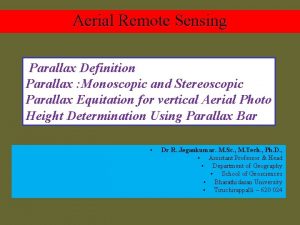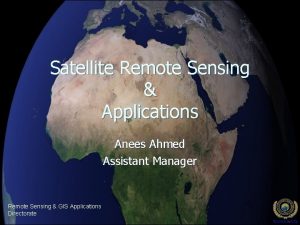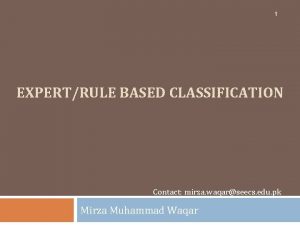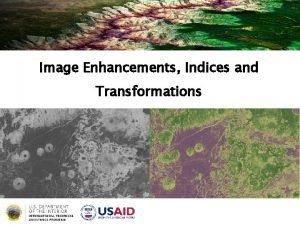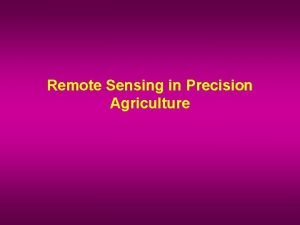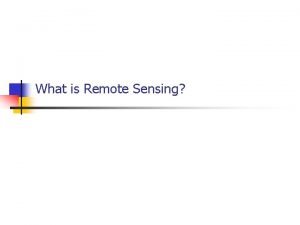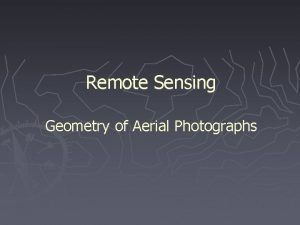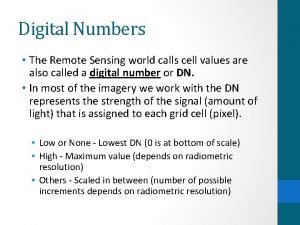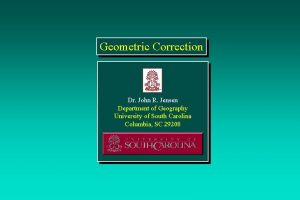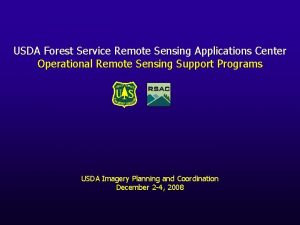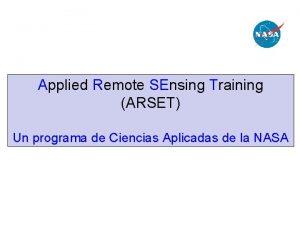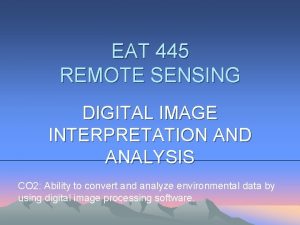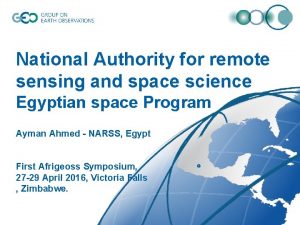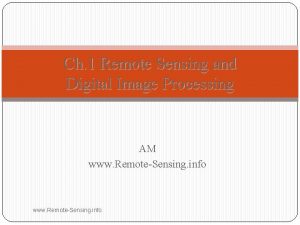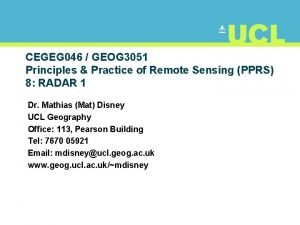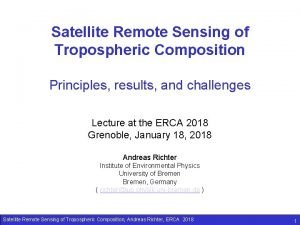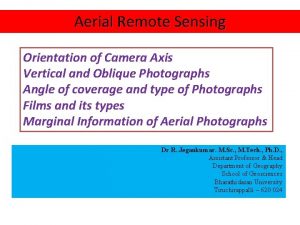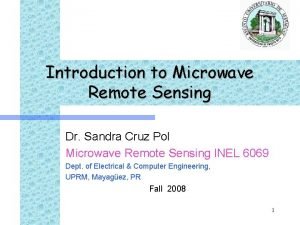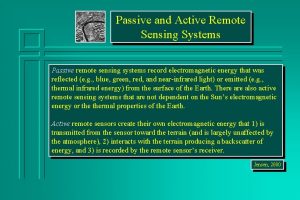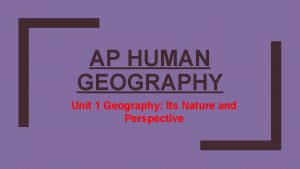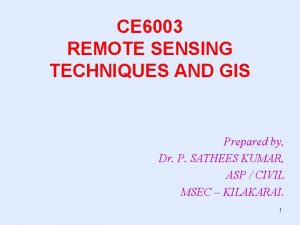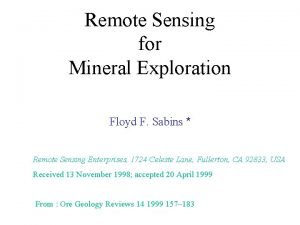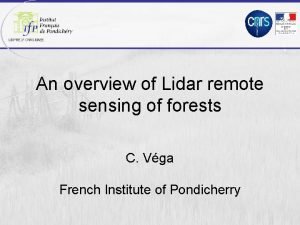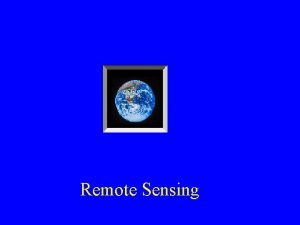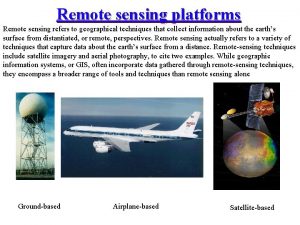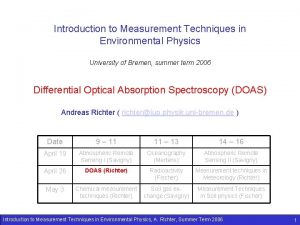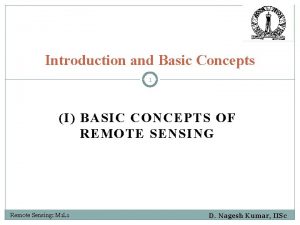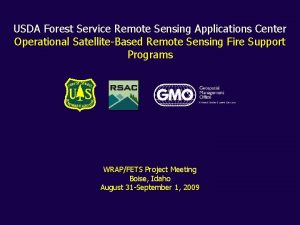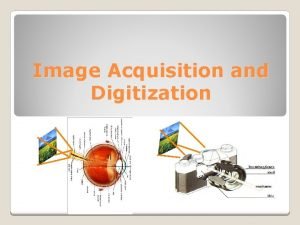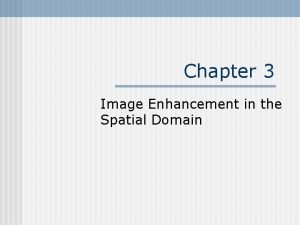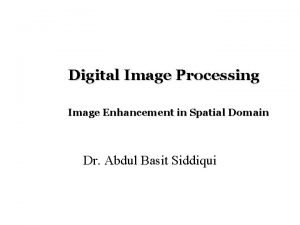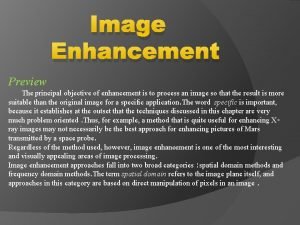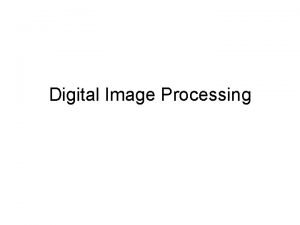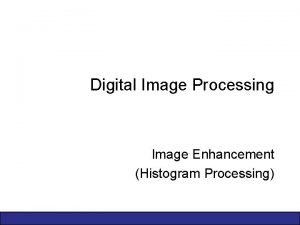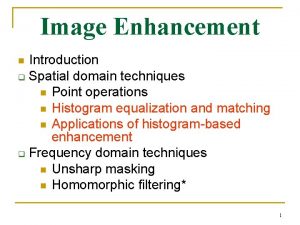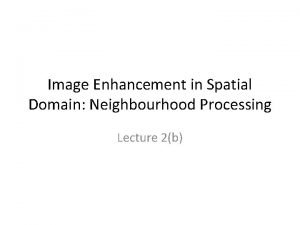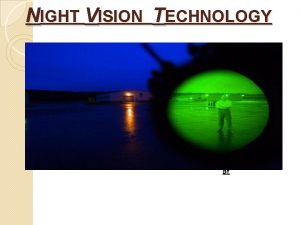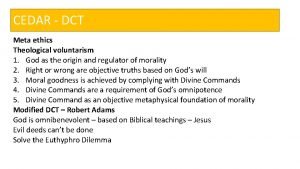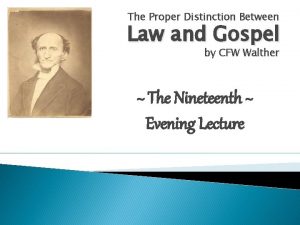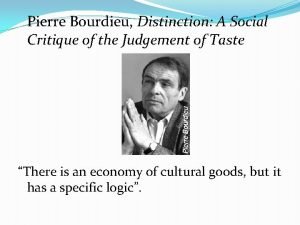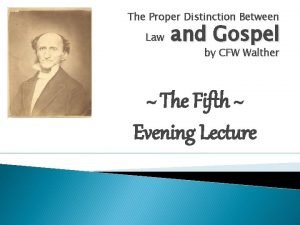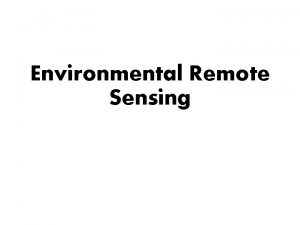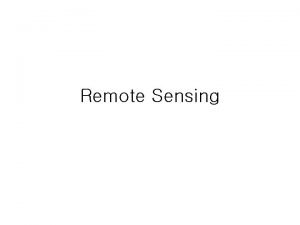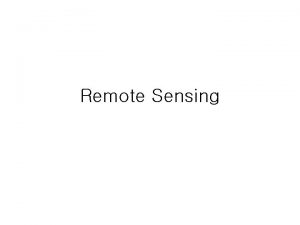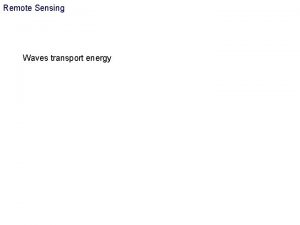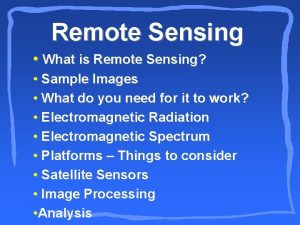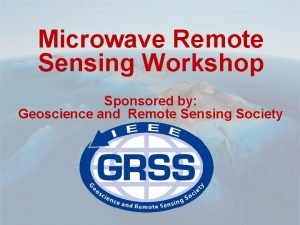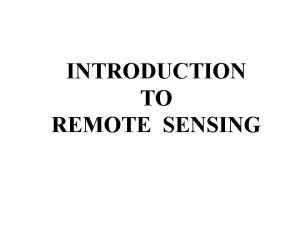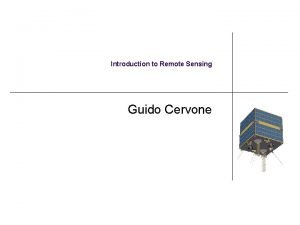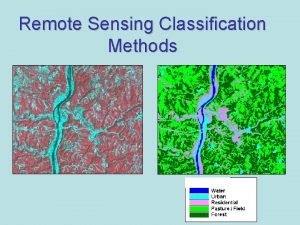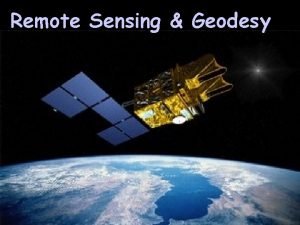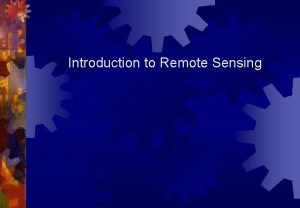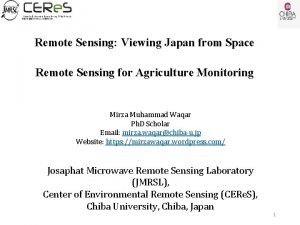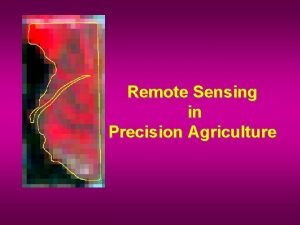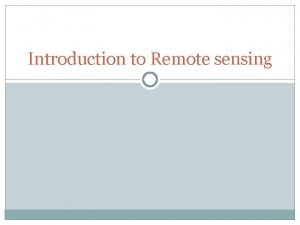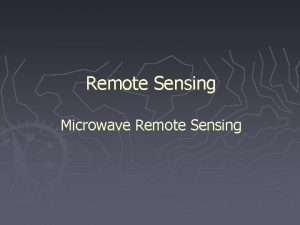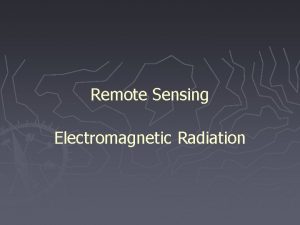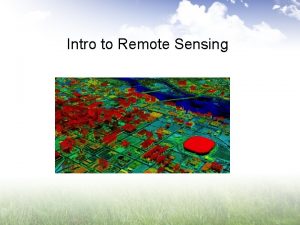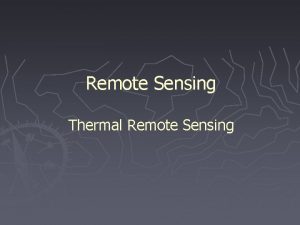Remote Sensing Image Enhancement Image Enhancement Increases distinction

















































- Slides: 49

Remote Sensing Image Enhancement

Image Enhancement ► Increases distinction between features in a scene Single image manipulation ► Multi-image manipulation ►

Single Image ► ► Contrast manipulation Spatial feature manipulation

1. Contrast Manipulation Gray-level threshold ► Level slicing ► Contrast stretching ► Histogram-equalized stretching ►

Contrast Manipulation. . Gray-level threshold segmenting an image into two classes - binary mask ► Level slicing dividing the histogram of DNs into several slices ►

Color-coded temperature maps derived from NIMBUS http: //rst. gsfc. nasa. gov/Sect 14_4. html

Contrast Manipulation. . ► Contrast stretching Expanding a narrow range of DNs to a full range DN - Min Linear stretch: DN = (-------) *255 Max - Min ► Advantage: simple computation Disadvantage: rare and frequent values have the same amount of levels

Stretching

Contrast Manipulation. . Histogram-equalized stretching ► Stretch based on frequency of occurrence ► Frequently occurred DNs have more display levels ► ► Special stretch

2. Spatial Feature Manipulation Spatial filtering ► Edge enhancement ► Convolution ► Directional first differencing ►

Spatial Filtering Low pass filters emphasize low frequency features ► Compute the average values of moving windows ►

Low Pass Filter Moving windows 3 4 5 0 1 Mean 6 8 3 1 5 4 3 2 3 4 0 2 1 4 4 2 3 8 0 5 1

Spatial Filtering. . High pass filters emphasize local details ► It subtracts the low-pass filter from the original image ►

Edge Enhancement Add back the high frequency image component to the original image ► Preserve both the original and the high frequency features ►

Convolution ► A moving kernel with a weighting factor for each pixel

Convolution

Directional Differencing Displaying the differences in gray levels of adjacent pixels ► The direction can be horizontal, vertical, or diagonal ► It is necessary to add a constant to the difference for display purposes ► Add back the directional difference to the original image ► ► Contrast stretching is needed for all feature manipulations


Convolution

3. Multi-image Manipulation ► ► Spectral ratioing Principle component transformation Kauth-Thomas tasseled cap Intensity-Hue-Saturation transformation (IHS)

3. 1 Spectral Ratioing A ratio of two bands (with great difference in reflectance) ► Useful to eliminate effects of illumination differences ► Select bands with distinct spectral responses ► Necessary to stretch the resultant values to a full range of DN values after ratioing ►

Band Ratioing. .

Band Ratioing. . 48 31 11 18 50 45 16 19 . 96 . 69 . 95 Band A ► ÷ ÷ Band B = = Ratio Band Based on the observation that the DNs for a same feature are lower in the shadow, and the DNs are reduced in a similar proportion between features

Hybrid Color Ratio Composite Problem: different features but of similar ratio may appear identical ► Solution: when display, combine two ratio bands + one original band to restore the absolute DN values ►

3. 2 Principle Component Transformation To reduce redundancy in multi-spectral data ► The transform DNI = a 11 DNA + a 12 DNB + a 13 DNC + a 14 DND DNII = a 21 DNA + a 22 DNB + a 23 DNC + a 24 DND DNIII = a 31 DNA + a 32 DNB + a 33 DNC + a 34 DND DNIV = a 41 DNA + a 42 DNB + a 43 DNC + a 44 DND ► DNI, - DNIV, - DNs in new component images DNA, -DND - DNs in the original images a 11, a 12, , a 44 - coefficients for the transformation


PCA

PC Transformation. . After the axes rotation, the original n bands images are converted into n principle components images ► The first component (PC 1) image contains the largest percentage of the total scene variance (90%+) ► The second component (PC 2) contains the largest of the remaining variance ►

PC Transformation. . ► Percentage component of variance explained by each %: 84. 68 10. 99 3. 15 0. 56 0. 33 0. 18 0. 10 ► Cul: 84. 68 95. 67 98. 82 99. 38 99. 71 99. 89 99. 99 ►

PC Transformation. . ► Loading: the correlation between each band each PC for output interpretation purposes Components Band 1 2 3 4 5 6 7 0. 649 0. 726 0. 199 -0. 014 0. 049 -0. 089 -0. 008 0. 694 0. 670 0. 178 -0. 034 0. 004 0. 099 0. 157 0. 785 0. 592 0. 118 -0. 023 -0. 018 …. 0. 894 -0. 342 0. 287 0. 017 ……

PCA

PC Transformation. . Successive components are orthogonal, and they are not correlated to each other ► PCs can be used as new bands for image classification ► PCA is scene specific ►

3. 3 Kauth-Thomas Tasseled Cap An orthogonal transformation ► The 4 MSS bands can be converted into 4 new bands: brightness greenness yellow stuff non-such ►

K-T Tasseled Cap ► SBI = 0. 332 MSS 4 + 0. 603 MSS 5 + 0. 675 MSS 6 + 0. 262 MSS 7 ► GVI = -0. 283 MSS 4 - 0. 660 MSS 5 + 0. 577 MSS 6 + 0. 388 MSS 7 ► YVI = -0. 899 MSS 4 + 0. 428 MSS 5 + 0. 0676 MSS 6 0. 041 MSS 7 ► NSI = -0. 016 MSS 4 + 0. 131 MSS 5 - 0. 452 MSS 6 + 0. 882 MSS 7

Kauth-Thomas Tasseled Cap The first two indices contain the most info (90%+) ► Brightness is related to bare soils ► Greenness is related to the amount of green vegetation ►

Kauth-Thomas Tesseled Cap

Kauth-Thomas Tasseled Cap The 6 TM bands can be converted into a 3 D space: plane of soil plane of vegetation and a transition zone ► A third feature, wetness ► The K-T transformation is transferable between scenes ►


K-T for TM ► Brightness = 0. 33 TM 1 + 0. 33 TM 2 + 0. 55 TM 3 + 0. 43 TM 4 + 0. 48 TM 5 + 0. 25 TM 7 ► Greenness = -0. 25 TM 1 - 0. 16 TM 2 - 0. 41 TM 3 + 0. 85 TM 4 + 0. 05 TM 5 - 0. 12 TM 7 ► Third = 0. 14 TM 1 + 0. 22 TM 2 - 0. 40 TM 3 + 0. 25 TM 4 - 0. 70 TM 5 -0. 46 TM 7 ► Fourth = 0. 85 TM 1 - 0. 70 TM 2 - 0. 46 TM 3 - 0. 003 TM 4 - 0. 05 TM 5 - 0. 01 TM 7

3. 4 IHS Intensity-Hue-Saturation transformation (IHS) ► Transform the RGB space into the IHS space to represent the information ► Intensity: brightness ► Hue: color ► Saturation: purity ►

IHS The hexcone model projects the RGB cube to a plane, resulting in a hexagon ► The plane is perpendicular to the gray line and tangent to the cube at the "white" corner ►




IHS Intensity = distance along the gray line from the black point to any given hexagonal projection ► Hue = angle around the hexagon ► Saturation = distance from the gray point at the center of the hexagon ►

IHS ► I, H, S = f(R, G, B) I' = f(I+Ipan) H' = f(H+Hpan) S' = f(S+Span) R', G', B' = f(I', H', S')


Readings ► Chapter 7

PCA. .
 Image parallax in remote sensing
Image parallax in remote sensing Remote sensing image
Remote sensing image Remote-sensing
Remote-sensing Geospatial data definition ap human geography
Geospatial data definition ap human geography Remote sensing
Remote sensing Remote sensing in precision agriculture
Remote sensing in precision agriculture N-rays
N-rays Fiducial marks in remote sensing
Fiducial marks in remote sensing Digital number remote sensing
Digital number remote sensing Geometric corrections
Geometric corrections Remote sensing applications center
Remote sensing applications center Applied remote sensing training program
Applied remote sensing training program Remote sensing ap hug
Remote sensing ap hug Digital interpretation in remote sensing
Digital interpretation in remote sensing Aerial photography in remote sensing pdf
Aerial photography in remote sensing pdf Remote sensing platforms
Remote sensing platforms Canadian centre for remote sensing
Canadian centre for remote sensing National authority for remote sensing and space sciences
National authority for remote sensing and space sciences Limitations of remote sensing
Limitations of remote sensing Remote sensing
Remote sensing Remote sensing physics
Remote sensing physics Strip camera in remote sensing
Strip camera in remote sensing Introduction to microwave remote sensing
Introduction to microwave remote sensing Active remote sensing
Active remote sensing Geospatial data definition ap human geography
Geospatial data definition ap human geography Idealized remote sensing system
Idealized remote sensing system Advantages of remote sensing
Advantages of remote sensing Full waveform lidar
Full waveform lidar Microwave remote sensing lecture notes
Microwave remote sensing lecture notes Ifov and fov in remote sensing
Ifov and fov in remote sensing Remote sensing physics
Remote sensing physics Components of remote sensing
Components of remote sensing Remote sensing applications center
Remote sensing applications center Image sensing and acquisition
Image sensing and acquisition Image enhancement in spatial domain
Image enhancement in spatial domain Image enhancement in spatial domain
Image enhancement in spatial domain Objective of image enhancement
Objective of image enhancement Logarithmic transformation in image processing
Logarithmic transformation in image processing Image enhancement
Image enhancement Pelembutan citra
Pelembutan citra Image enhancement in spatial domain
Image enhancement in spatial domain Point processing in image processing
Point processing in image processing Image enhancement in spatial domain
Image enhancement in spatial domain Image enhancement in night vision technology
Image enhancement in night vision technology Is/ought distinction
Is/ought distinction Discuss five difference between guidance and counselling
Discuss five difference between guidance and counselling The difference between right and wrong is clear
The difference between right and wrong is clear The proper distinction between law and gospel
The proper distinction between law and gospel Pierre bourdieu distinction
Pierre bourdieu distinction The proper distinction between law and gospel
The proper distinction between law and gospel
